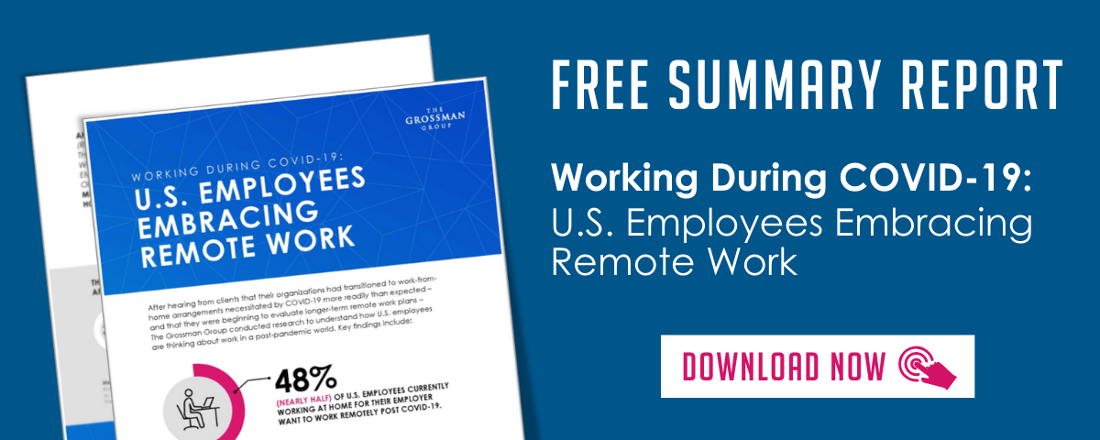New Study from The Grossman Group: Nearly Half of Employees Now Working from Home Want to Stay Remote

One of the major impacts of the COVID-19 pandemic will be on the future of workplaces around the world. A new study from our team at The Grossman Group bears this out – with 48 percent of employees working from home now saying they’d like to keep that arrangement.
If even only a portion of those employees get their wish, that would still represent a major shift in the remote workforce. Prior to COVID-19, only 7 percent of U.S. private sector workers had access to a “flexible workplace” benefit, or telework, according to a prominent study of the U.S. Workforce – the 2019 National Compensation Survey (NCS) from the federal Bureau of Labor Statistics. Many of those teleworkers were managers or other white-collar professionals.
Employers are Beginning to Re-Think the Future of Work
We initiated our study based on our interactions with clients in the early days of the pandemic. Many leaders were pleasantly surprised by how quickly employees adjusted to remote working, which prompted questions about employee preferences and whether work-from-home options should expand once the pandemic subsides.
The Grossman Group conducted the online survey of 841 current U.S. employees across a variety of sectors from April 27 to May 1, 2020.

Many Employees Appreciated Employers’ Response to the Pandemic
Overall, employees working from home had high marks for their employers’ response to the pandemic. This may have helped build their confidence in a remote working situation for the long-term.
Key findings from employees working from home:
- 78% agreed their company leadership has lived up to the values of their organization during this time
- 90% said their trust in their organization increased or stayed the same
- 88% said their satisfaction with their organization as an employer increased or stayed the same
- 80% agreed that their direct supervisor is communicating the information they need to do their jobs during the pandemic
Among all participants, regardless of whether they are currently working for their employer remotely or on-site:
- More women than men want to work from home after the pandemic:
- 43% of women want to work from home
- 34% of men want to work from home
- There is little generational difference in where people want to work after the pandemic:
- 39% of Gen Z want to work from home
- 38% of Millennials and Gen X want to work from home
- 37% of Baby Boomers want to work from home
Employees Crave Flexibility
Employee work preferences still differ and working from home is not for everyone – either because employees simply cannot do their jobs remotely or would prefer not to. Still, the survey findings are a clear signal to employers that preferences are rapidly evolving. If we want employees to stay engaged and productive, we need to meet them where they are.
I’m also confident that being flexible is a win-win for companies and their people. In my daily interactions with large multinational companies and small businesses, I’ve seen that employees who feel heard, supported and genuinely appreciated are more engaged, loyal and willing to work harder to achieve a company’s goals. The employee/employer relationship is critical to any organization’s success.
I recognize that some employers may find the growing interest in remote working difficult to accept, as many believe that spending more time on site is the best way to be more productive. Yet during the pandemic, even employers who traditionally expected employees to be in the office most of the time learned just how capable and resourceful employees can be, no matter where they are.
Further, many studies have shown that employees who work from home are at least as productive or more productive than those in the office. A frequently cited 2015 study by Stanford economist Nicholas Bloom reported many benefits from working from home, including higher productivity and a lower attrition rate. However, that prominent study produced cautionary findings as well. Bloom found that many employees in the company he studied later changed their mind about wanting to work from home 100 percent of the time, as they felt too isolated. This led Bloom to recommend working from home a few days a week rather than constantly.
The message to me is clear: A one-size-fits-all approach is not the wave of the future. Thinking more creatively and being open to new working arrangements adds value to the employee experience, builds engagement, and brings results.
Get Details on the Working During COVID-19: U.S. Employees Embracing Remote Work Study
To download the findings, click here.
What do you think is the best approach to remote work arrangements? In your own experience, are there more upsides or downsides to expanding work-from-home options?
—David Grossman
Click below to download the summary report—Working During COVID-19: U.S. Employees Embracing Remote Work—and get data to help you understand how U.S. employees are thinking about work in a post-pandemic world.


Comments on this post